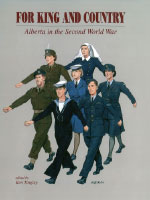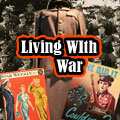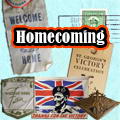Popular Culture in Edmonton During the Second World War
David Leonard
Reprinted with permission of the author and publisher of For King and Country: Alberta in the Second World War The ideals of Edmonton were greatly wrapped up in the ethos of the British Commonwealth, and therefore the Canadian Crown. It had come to represent fairness, tolerance and harmony among diverse peoples seldom witnessed in other parts of the world. Hence the enthusiasm which greeted George VI in June 1939. Though he stayed in Edmonton only six hours, he and Queen Elizabeth took the city by storm. Over 68,000 people, in a city of90,419, flocked to see his motorcade as it rolled down Portage Avenue, shortly to be renamed Kingsway.4 Many had travelled miles in special trains and motor caravans to witness the great event.
The ideals of Edmonton were greatly wrapped up in the ethos of the British Commonwealth, and therefore the Canadian Crown. It had come to represent fairness, tolerance and harmony among diverse peoples seldom witnessed in other parts of the world. Hence the enthusiasm which greeted George VI in June 1939. Though he stayed in Edmonton only six hours, he and Queen Elizabeth took the city by storm. Over 68,000 people, in a city of90,419, flocked to see his motorcade as it rolled down Portage Avenue, shortly to be renamed Kingsway.4 Many had travelled miles in special trains and motor caravans to witness the great event.
Despite this satisfaction with British ties, the early 20th century also had witnessed the gradual, but inexorable, invasion of American popular culture. In many respects, the city which greeted King George was an Americanized city. Itself a "melting pot of nations," the United States had for some time been in the process of cultivating distinctive art forms, architecture, literature, wearing apparel and culinary trends which by 1939 were reflected around the world. Aided by immense wealth, large worldwide immigration, and turn-of-the-century technology which developed the gramophone, cinema, radio and rapid transportation, the United States was well on its way towards setting international trends in 20th century popular culture, at least in the western world.
When King George arrived in Edmonton, there were ten motion picture theatres in operation. The movies then playing had all been made in Hollywood. They included Broadway Serenade, Return of the Cisco Kid, Stage Coach, East Side of Heaven, Man of Conquest, The Desert Song, A Man to Remember, Home on the Prairie, The Lady Vanishes, Spring Madness, Vacation From Love, Young Heart, and There's That Woman Again. Among the five radio stations Edmontonians were listening to were NBC from Denver and CBS from Salt Lake City. In the evenings, a host of other American stations could be picked up. CFRN was the Canadian Broadcasting Corporation station, and therefore presented extensive eastern Canadian broadcasting, while CKUA, operated from the University of Alberta, featured mostly classical music. CJCA, however, presented the "pop music" of the day, which was predominantly American big band music. Other programmes on CJCA on 2 June 1939 included Eddie Allen, Doc Salera True Stories, Road of Life, Mary Martin, Ma Perkins, Pepper Young Family, The Guiding Light, Curly, The Yodelling Cowboy and Campbell's Playhouse.
On the newsstands of Edmonton were many of the same American magazines which were widely read in later years, with The Saturday Evening Post, Life, Time and Newsweek among the most familiar. American pocket books were prevalent, while at the juvenile level, comic books featuring a host of American heroes such as Superman, Ozark Ike and Dick Tracy were becoming popular. Cartoons in the local newspapers were largely from American syndicates. In June 1939, these included Little Orphan Annie, Moon Mullins, Gasoline Alley, Dick Tracy and Alley Oop.
Non-American trends in popular culture did not disappear; except for British cultural influences, however, they were not pervasive. Newspapers like The Ukrainian News and journals like La Survivance continued to be read, but not outside their respective ethnic groups. On radio, programmes like The Ukrainian Hour, which could later be heard by all, were not a feature in 1939. Public socializing along ethnic lines was very common, and Edmonton was far more a cultural mosaic in 1939 than it would be ten years later.
Three months after the Royal Visit, Germany invaded Poland and the series of cataclysmic events known as the Second World War began to unfold. Like most of Canada, Edmonton became emotionally committed to the cause of Great Britain. In particular during the summer of 1940, when Britain stood virtually alone against Hitler's aerial onslaught, the Edmonton papers were filled with stories and photos about the valiant defence of the island nation. Within a week of the invasion, Prime Minister Mackenzie King announced Canada's active participation in opposition to Hitler and Mussolini. The country was at war, and so was Edmonton. On the day of the invasion, the Edmonton Regiment was put on a war footing under Colonel Stillman and began to sign up recruits. The City began to brace itself for combat.
Unlike the First World War, the Second was to bring Edmonton instantly out of a depression, and to a great extent would mould the economy and physical face of the city. The character of Edmonton also would be greatly affected by the war, which would see a greater blend of its ethnic communities. The city which would gasp spellbound at the news of Hiroshima in 1945 was vastly changed from that which gleefully cheered the arrival of King George a little more than six years earlier.
Unlike many wars, the Second World War provided most people in the Allied camp with a clear sense of direction. In the public mind, there was no doubt as to who was the aggressor and who was the defender. There was also little doubt as to the just cause of the peoples attacked and the valour of those who fought back. Germany, Italy and later Japan, were clearly wrong and must be stopped. The battle for survival was also a battle for justice. The justice of the Allies and the evil of the Axis were concepts firmly implanted in the public mind for the duration of the war. As a result, a clear sense of purpose took hold over many communities in the western world, including Edmonton. The despondency and empty solutions spawned by the Depression were now over. Something more alarming, but more identifiable and therefore more combatable, now faced the people, civilian as well as political and military.
The war soon brought economic rewards for Edmonton. Demands were made on local industry, and people began to flock to the city. Although many Edmonton men and women were sent overseas or to eastern Canada, the city increased its population by 3398 in two years. Many of these newcomers came from Britain and other parts of the Commonwealth when Edmonton was chosen as a major centre for the British Commonwealth Air Training Plan. Early in 1942, however, the emphasis began to shift when the Japanese attack on Pearl Harbor jolted the United States instantly into the war. As one of the most compelling early concerns was a possible invasion of Alaska, plans were immediately put in place for the defence of this remote territory. Edmonton, as Canada's "Gateway to the North", was chosen to be the Canadian administrative centre for the Northwest Staging Route, the Canol Project, and especially for the construction of the Alaska Highway. Before long, thousands of Americans began to flood into the city to fill various war-related administrative and industrial jobs. By late 1942, they exceeded 15,000 in number.5 Accommodation was at a premium, and many Americans had to board with local families. The fact that they blended in as well as they did with the resident population attested to the unity of purpose felt by Canadians and Americans alike. It also attested to the extent to which Edmonton, a city over three hundred miles from the United States border, had become acclimatized to the American way of life.
It is in the popular culture of the time that so much of what people felt during the war years was given expression. Fear, anger, hatred, longing, heartbreak, patriotism, determination and exuberance were all engendered by the war, and were all reflected in the movies, radio programmes, music, novels and magazines of the day. Wartime controls generally kept prices in check. However, with rationing people did not have access to many of the commodities which they had enjoyed before the war. Nevertheless, with increased purchasing power, they were better able to entertain themselves. The disruption of family life, with fathers, mothers, sons and daughters frequently serving in distant locations, compelled many people to seek solace outside the home. During the Depression, economic restraint and the widespread popularity of radio had served to keep families together at home. Now people ventured out more into the open, to cinemas, restaurants, dance halls, night clubs, canteens, bars, or simply to the homes of other people.
Notes
4. Edmonton Bulletin, 3 June 1939.
5. Sean Moir and Steve Boddington, “The Friendly Invasion”: The American presence in Edmonton 1942-1945, in this volume.








